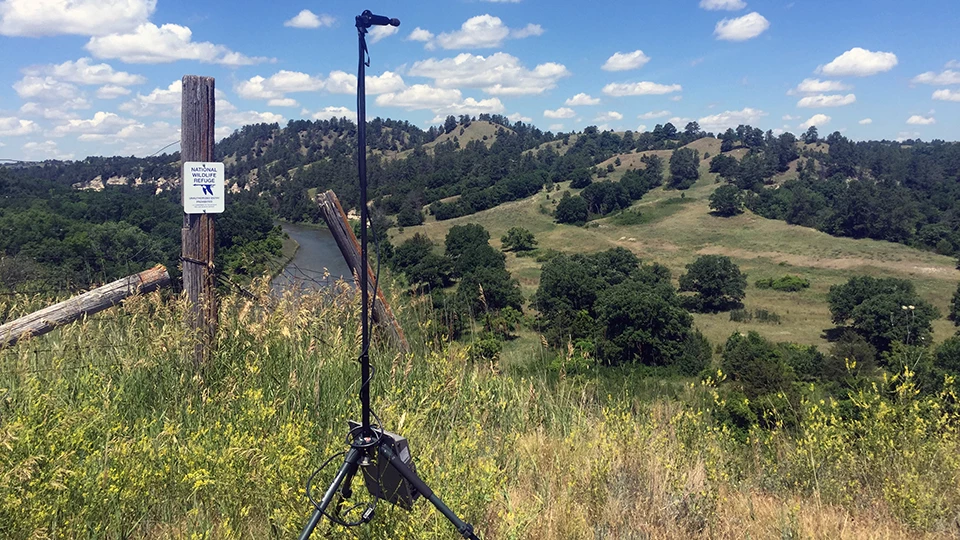Last updated: March 22, 2019
Article
Bat Acoustic Monitoring at Niobrara National Scenic River

NPS/Cumberland Gap National Historic Park
Overview
Niobrara National Scenic River is located in northern Nebraska. Managed by multiple agencies and private landowners, this 29,101-acre park includes 76 miles of the winding river. Riparian and upland forests, bluffs, and surface waters in the park may provide good bat foraging and roosting habitat. High bat activity occurs in the habitat along the Niobrara River and in the wooded draws. Some bats can eat thousands of mosquitoes each night making them important for insect control in the campgrounds along the river.
The Northern Great Plains Inventory & Monitoring Network monitors bats to detect long-term trends and to get early warning of undesirable changes in bat populations at the park. A fungal disease called white-nose syndrome is spreading quickly, threatening bat populations in North America. First documented in a New York cave in 2006, this disease is associated with more than seven million bat deaths. It spreads primarily from bat to bat and humans might be spreading the disease by carrying nearly invisible fungal spores on their shoes and clothing from one cave to another. Bat monitoring helps us understand changes occurring with the spread of this devastating disease.
Acoustic Monitoring
Eight acoustic recording stations and two mobile survey routes were established in 2015 at Niobrara National Scenic River. Acoustic recorders detect the unique ultrasonic calls bats use for echolocation. Several of the monitoring stations were on private land and Fort Niobrara National Wildlife Refuge, managed by U.S. Fish & Wildlife Service. We share results with these network partners. There were 72,705 bat call recordings from stations across all survey nights from 2014 to 2017. The data were analyzed through specialized software programs that make preliminary identifications of the bat species based on individual call characteristics, such as frequency and shape. Some bat species make calls that are similar to other species, which is why researchers with special expertise review the calls and make the final species determinations.

NPS
Bats at the Park (2015–2017)
| Common Name | Scientific Name | 2014–2017 Status |
|---|---|---|
| Big brown bat | Eptesicus fuscus | Present |
| Eastern red bat | Lasiurus borealis | Present |
| Hoary bat | Lasiurus cinereus | Present |
| Silver-haired bat | Lasionycteris noctivagans | Present |
| Western small-footed myotis | Myotis ciliolabrum | Present |
| Northern long-eared bat | Myotis septentrionalis | Probably Present |
| Evening bat | Nycticeius humeralis | Probably Present |
| Tri-colored bat | Perimyotis subflavus | Present |
- Big brown, silver-haired, and hoary bats were were recorded more often than other species. Listen to a silver-haired bat call!
- Silver-haired, evening and tri-colored bats were new detections for the park. Niobrara National Scenic River lies at a crossroads between several major ecological communities. The evening and tri-colored bats, commonly associated with eastern North America, have expanded their ranges westward.
- The threatened northern long-eared bat is probably present at the park based on a small number of bat calls. Acoustic monitoring is good at identifying some species, but other closely-related species often sound alike so the software is less certain about their presence unless it detects a lot of calls.
- During mobile acoustic surveys, sections of road along the Niobrara River and wooded draws had more bat detections than sections through open-country and prairie croplands.

USFWS
White-nose Syndrome
White-nose syndrome has not yet been detected at the park, but the fungus (Pseudogymnoascus destructans) that causes it was detected in 2017 on bats at Badlands National Park to the northwest of Niobrara National Scenic River. See a map of white-nose syndrome in national parks and learn more about how you can help prevent the spread of this fungus. Continued monitoring, and park staff and visitor observations, will help us protect the bat communities that live and forage in the park.
For More Information
Dan Licht, Midwest Region Wildlife Biologist
Protocol Contact: Northern Great Plains Network
